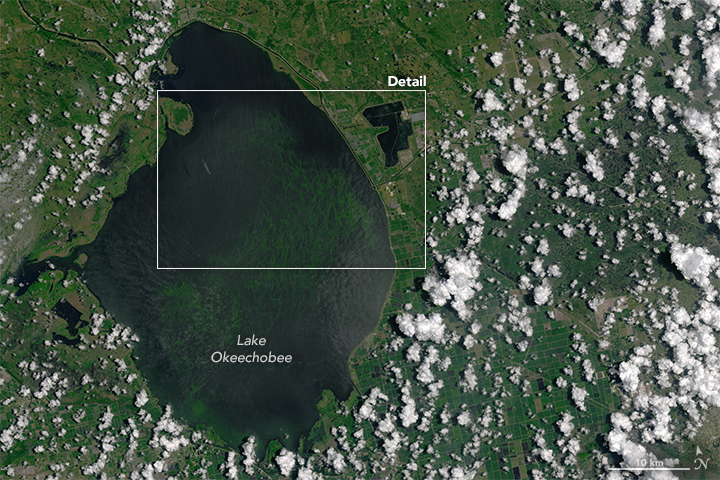15
Jul
Toxic Algae Bloom in Florida’s Largest Lake Tied to Chemical-Intensive Agriculture

Image from NASA
(Beyond Pesticides, July 15, 2016) A toxic algae bloom that has expanded throughout Florida’s largest freshwater body, Lake Okeechobee, and around south Florida beaches, has created vast problems for residents, compelling Governor Rick Scott to declare an environmental state of emergency. However, the Governor’s declaration fails to address the root of the problem””including the extreme levels of nutrient buildup and the dangerous amount of phosphorous and nitrogen found in the water, caused by excess fertilization runoff from both chemically-intensive agricultural and residential sources. Instead, Gov. Scott has placed blame on the federal government due to their lack of proper maintenance on the Herbert Hoover Dike, which prevents Lake Okeechobee from overflowing into nearby water sources. While this is certainly problematic, the crux of the issue stems from the polluted water itself, which allows bacteria to grow swiftly when nutrients like phosphorus and nitrogen are abundant.
“We just are putting way too much nitrogen and phosphorus into our natural waters, and they respond,” Florida Atlantic University research professor, Bill Louda, Ph.D. told CBS news.
A few weeks ago, the U.S. Army Corps of Engineers, Jacksonville District, as a means of flood prevention, released the lake’s water into local canals with a large amount of nutrient pollution. Jackson Kirk of the U.S. Army Corps of Engineers, stated, “Part of our mitigation to prevent a breach situation includes managing the water level in the lake to keep it from rising too high. Unfortunately, this requires releasing water in quantities that, when combined with an equally large volume of basin runoff, upset the freshwater-saltwater mix in the estuaries. The change in that mix, coupled with hot weather, and excessive nitrogen and phosphorus in the system from a variety of sources, are all among the factors fueling the algae affecting the estuaries.” The U.S. Army Corps of Engineers, Jacksonville district, released a statement on July 14 stating they “will further reduce the amount of water flowing from Lake Okeechobee beginning this weekend.”
This algae bloom, which, according to NASA grew to cover 33 square miles as of May 2016, has been called “unprecedented” by many of Florida officials. In reality, this type of occurrence has been on the rise over the past few years throughout the country. Similar to the algal blooms that occurred in Lake Erie back in 2013, Lake Okeechobee is both extremely shallow, averaging about 9 feet deep, warm, and surrounded by industrial agricultural land, making its water more prone to this type of algal bloom. Hotter and more frequent extreme weather events alongside harmful trends in chemically-intensive, conventional agricultural practices have caused these destructive algal blooms to strike more frequently in these types of waterbodies.
“Basically, we are fertilizing Florida to death,” Dr. Louda told Huffington Post. “You could throw some nasty herbicides or synthetic inhibitors on top of it, but it would kill everything else too, the seagrass, the phytoplankton fish eat. We just have to let nature take its course.” Dr. Louda, who is based in Boca Raton, has been studying and testing the algae.
Fertilizer runoff not only causes what many news outlets are describing as the smelly “guacamole thick” toxic algal blooms, it can also severely harm humans and aquatic wildlife. An unnaturally high level of phosphorous in aquatic ecosystems creates a setting that compromises the diversity, stability, and resiliency of the natural environment. Once algae die off, aerobic bacteria consume the dead algae, resulting in dangerously low oxygen “dead zones,” which further decrease biodiversity. In a study done by Environment America, agribusiness pollution is a leading cause of dead zones that plague waters all over the United States, estimating “manure footprints” of major agribusiness companies. The manure that is generated as waste by these companies is put on crop land, leading to run off issues.
Furthermore, the U.S. Environmental Protection Agency (EPA), alongside many environmental advocates and scientists, believe climate change impacts have begun to make these type of conditions in which blooms thrive a common occurrence.
Community members and those visiting the affected areas have also voiced frustration and concern over the known health effects associated with exposure to toxic algae. Many report experiencing symptoms such as headaches and respiratory problems that they believe are linked to the outbreak. The Florida Department of Environmental Protection has been consistently monitoring the blooms and urges residents to report new blooms.
Audubon Florida, an environmental group, recommends multiple long-term solutions to protect the health of Lake Okeechobee and surrounding waters, including an update to the state’s Basin Management Action Plan (BMAP) to fully address the scope of the negative water quality as a result of unnaturally high nutrient levels. It also recommends more focus on monitoring and enforcement of on-farm Best Management Practices (BMPs), which is a step in the right direction, but falls short of organic standards.
Organic farming and land management uses natural, less soluble sources of nitrogen, phosphorous and magnesium; including cover crops, compost, manure and mineralized rock, in order to promote increases in soil organic matter and a healthy soil structure. Healthy soil structure allows water to infiltrate the ground slowly, rather than escaping across the surface and carrying soil particles, nutrients, and other inputs with it. Also, it allows plants to establish vibrant root systems that resist erosion. For more details, see Beyond Pesticides fact sheet, Organic Land Management and the Protection of Water Quality. In addition to agricultural practices, residential use of lawn care fertilizers represents a significant portion of the phosphorous load that runs into local water bodies in the U.S. For more details on how to prevent phosphorous contamination, see Beyond Pesticides’ article Maintaining a Delicate Balance.
For further resources on pesticides and water quality, please visit Beyond Pesticides’ Threatened Waters page.
Sources: NASA, CBS News, Huffington Post
All unattributed positions and opinions in this piece are those of Beyond Pesticides.










